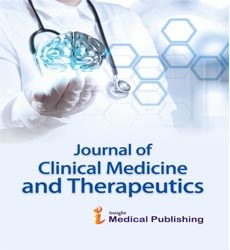Direct Oral Anticoagulants vs. Warfarin in Morbidly Obese Patients with Nonvalvular Atrial Fibrillation..
Alexander Birbrair*
Department of Pathology, Federal University of Minas Gerais, Belo Horizonte, MG, Brazil
- *Corresponding Author:
- Alexander Birbrair
Department of Pathology
Federal University of Minas Gerais
Belo Horizonte, MG, Brazil
E-mail: alexbirb@gmail.com
Received Date: September 10, 2021; Accepted Date: September 15, 2021; Published Date: September 20, 2021
Citation: Birbrair A (2021) Direct Oral Anticoagulants vs. Warfarin in Morbidly Obese Patients with Nonvalvular Atrial Fibrillation. J Clin Med Ther. Vol 6 No.1:2
Editorial
Direct Oral Anticoagulants (DOACs) have been progressively liked over warfarin; notwithstanding, The International Society of Thrombosis and Hemostasis suggested keeping away from the utilization of DOACs in excessively fat patients (weight file >40 or weight >120 kg) due to restricted clinical Information on understanding qualities, comorbidities, essential anticoagulation signs, pharmacologic treatment, and results were gathered. The essential result of revenue was stroke or foundational embolism (SSE) rate. The optional result was significant dying (MB). Atrial fibrillation (AF) keeps on being the most well-known arrhythmia, with an expected 12.1 million individuals are relied upon to have AF by 2030 in the United States. AF is related with expanded all-cause mortality, with death frequently credited to coronary corridor sickness or cerebrovascular mishaps (CVA). Treatment for AF means to mitigate side effects, diminish the danger of stroke, and forestall tachycardia-related cardiomyopathy. Nonetheless, stoutness keeps on being an overall wellbeing trouble. Stoutness is a grounded hazard factor for both AF and stroke.
Pharmacological anticoagulation for stroke anticipation is essential in the administration of AF. Direct oral anticoagulants (DOACs) have been progressively liked over warfarin since they have restricted dietary limitation, less medication collaborations, and fixed dosing routine with less observing prerequisites. In any case, weight might result in imperfect anticoagulation, given conceivable modified pharmacokinetics and pharmacodynamics attributes of DOACs. The International Society of Thrombosis and Hemostasis suggested keeping away from the utilization of DOACs in patients with a weight file (BMI) >40 or weight >120 kg in view of restricted clinical information in these patients.
Scarcely any new investigations have detailed utilizing DOACs for AF in beefy beyond belief patients. Be that as it may, information with respect to the adequacy and security of DOACs in this populace stay inadequate. Accordingly, we led this metaexamination to assess all the accessible proof to more readily evaluate the viability and wellbeing of DOACs in contrast with warfarin in butterball shaped patients with nonvalvular AF.
A subgroup investigation of the Randomized Evaluation of Long-term Anticoagulation Therapy study showed that weight essentially influenced dabigatran plasma concentrations.27
Furthermore, scarcely any case reports exhibited thromboembolic occasions in butterball shaped patients while on dabigatran treatment with subtherapeutic plasma concentration. However, in our review, dabigatran was not substandard compared to warfarin in the counteraction of SSE occasions, which had the option to be demonstrated by pooling information and expanding the ability to distinguish the factual contrast.
The weight conundrum hypothesis "lower or similar SSE and death rates in heftiness contrasted with non-obesity in patients with AF getting DOACs or warfarin" has been portrayed in a few studies.30 Our outcomes are steady with Kido, who revealed lower MB rates in beefy beyond belief patients with AF with practically identical adequacy to warfarin. In any case, our metainvestigation included 5 additional examinations, with a generous number of included patients (n = 89,494 patients vs. 4421), and subsequently prompts a more strong end on the viability and wellbeing of DOACs. Also, our review showed the prevalence of DOACs over warfarin in forestalling SSE; this could be conceivable by pooling the information from more investigations to distinguish the generous contrast recently veiled by under powering of the past reports. Accordingly, the heftiness mystery hypothesis might reach out to the beyond husky associate of patients with AF; as displayed in our outcomes, DOACs are better than warfarin with a superior wellbeing profile. As far as we could possibly know, our meta-examination is quick to demonstrate the prevalence of DOACs in regards to the viability and wellbeing in patients with nonvalvular AF and very high body weight.
Our review has specific constraints. To begin with, the greater part of the investigations were review associate examinations.
Second, we were unable to explore edoxaban, given the restricted information. Third, a few investigations didn't give insights about the portion of DOACs utilized; consequently, we were unable to test the utility of DOACs dependent on the dosages utilized (standard vs. decreased portion). Fourth, huge heterogeneity can be noticed for the wellbeing result; by the by, the affectability examinations and the re-assessed values proposed the significant heterogeneity can't be clarified by each study. At last, our review was led in patients with AF; this will block the speculation of our outcomes to different accomplices of patients requiring fundamental anticoagulation treatment.
Notwithstanding, our review has a few qualities. We incorporated a hearty number of patients. Supposedly, this is the first metainvestigation to show the prevalence of DOACs in beyond husky patients with AF, which we suspect was recently thought little of due to underpowering. At long last, we played out a subgroup examination of 3 subclasses of DOACs, and the outcomes underscore the clinical adequacy and wellbeing among them.
Taking everything into account, our review exhibited that DOACs are powerful and safe when contrasted and warfarin in butterball shaped patients. In any case, more huge scope randomized clinical preliminaries are expected to additionally assess the viability and wellbeing of DOACs contrasted and warfarin in this companion of patients
Open Access Journals
- Aquaculture & Veterinary Science
- Chemistry & Chemical Sciences
- Clinical Sciences
- Engineering
- General Science
- Genetics & Molecular Biology
- Health Care & Nursing
- Immunology & Microbiology
- Materials Science
- Mathematics & Physics
- Medical Sciences
- Neurology & Psychiatry
- Oncology & Cancer Science
- Pharmaceutical Sciences
